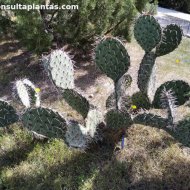Care of the cactus Opuntia valida or San Antonio prickly pear |
|
The genus Opuntia, family Cactaceae, includes about 300 species of cacti native to Mexico, the USA, and Central and South America. Some species are: Opuntia valida, Opuntia macrocentra, Opuntia chlorotica, Opuntia rufida, Opuntia robusta, Opuntia polyacantha, Opuntia microdasys, Opuntia linguiformis, Opuntia leucotricha, Opuntia engelmannii, Opuntia bergeriana, Opuntia santa-rita, Opuntia ficus-indica, Opuntia durangensis, Opuntia subulata, Opuntia aciculata, Opuntia atrispina, Opuntia phaeacantha, Opuntia auberi, Opuntia lindheimeri, Opuntia basilaris, Opuntia vestita, Opuntia spinulifera. Common names: San Antonio prickly pear. This species is native to northern Mexico and southwestern USA. They are shrub cactus of erect or crawling that reach 1 meter (3.28 feet) high and 2 meters (6.56 feet) wide. The large cladodios (segments) are blocked green. The big brown areolas have gloquidios and 2-5 whitish rigid spines. The flowers are yellow and bloom in spring. The fruits are purple. San Antonio prickly pear is used to form impenetrable barriers, such as isolated specimens, to cover dry and sunny slopes and in rock. It's ideal for Mediterranean gardens. Opuntia valida needs an exposure of full sun and a warm and dry climate. Resists frost to -10 ºC (14 ºF) if the substrate is dry. San Antonio prickly pear grows in any well drained soil either sandy, poor, rocky or stony. Opuntia valida resists drought very well. Always water moderately waiting for the substrate to have dried. San Antonio prickly pear does not need fertilizer or pruning. Opuntia valida does not usually have pest and disease problems if there is no excess moisture. It propagates through segment or stem cuttings and from seeds planted in spring. |
Images of the cactus Opuntia valida or San Antonio prickly pear |
Find plants
Opuntia valida or San Antonio prickly pear | Care and Growing
© 2026 FavThemes






